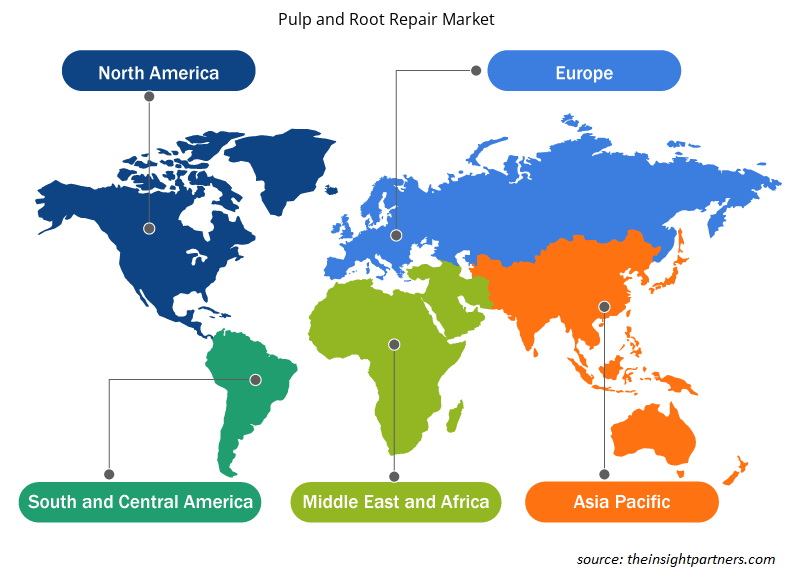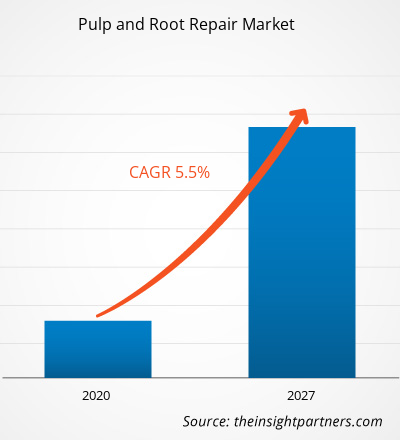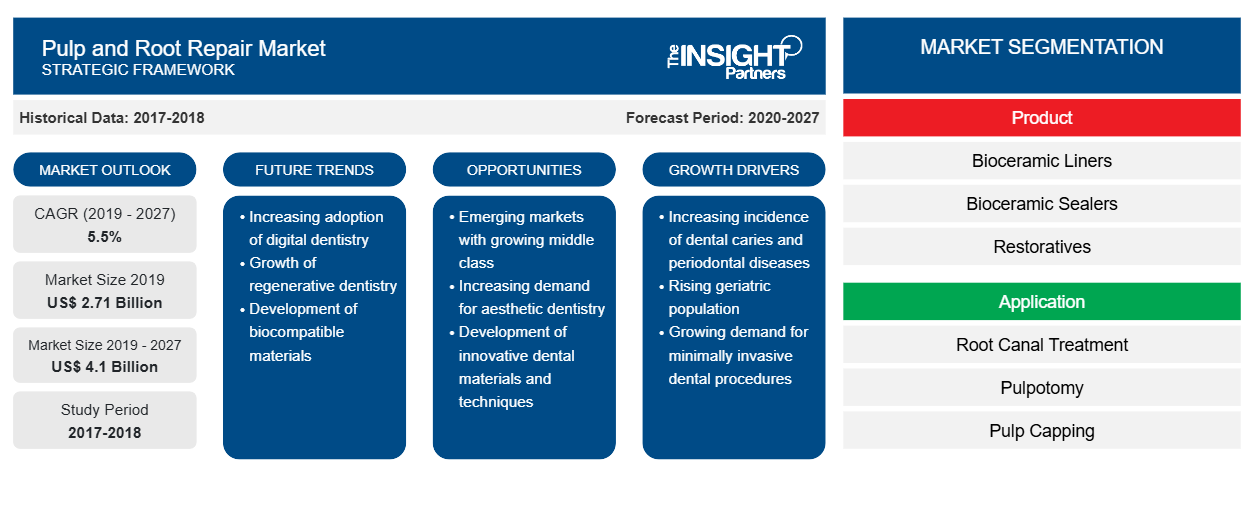Der Markt für Pulpa- und Wurzelreparaturen wurde im Jahr 2019 auf 2.706,43 Millionen US-Dollar geschätzt und soll bis 2027 einen Wert von 4.097,13 Millionen US-Dollar erreichen; von 2020 bis 2027 dürfte er mit einer durchschnittlichen jährlichen Wachstumsrate von 5,5 % wachsen.
Das Zahnmark ist der weiche Bereich in der Mitte eines Zahns und besteht aus Bindegewebe, Nerven und Blutgefäßen. Faktoren wie Karies, Verletzungen, bakterielle Infektionen und Zahnlöcher können zu einer Schädigung des Marks führen. Bei einer Schädigung beginnt das Mark zu zerfallen, was zu einer bakteriellen Infektion führt. Wurzelkanalbehandlung, Pulpaüberkappung und Pulpotomie sind einige der Verfahren, die zur Behandlung von geschädigtem Mark empfohlen werden. Die zunehmende Verbreitung solcher Erkrankungen des Marks und der Wurzel sowie steigende Investitionen in die Endodontie treiben den globalen Markt für Pulpa- und Wurzelreparaturen an. Die hohen Kosten für Zahnbehandlungen hemmen jedoch das Marktwachstum.
Die erheblichen Auswirkungen der COVID-19-Pandemie auf den Markt für Pulpa- und Wurzelreparaturen werden voraussichtlich die nächsten Quartale andauern. Die Verhängung von Ausgangssperren und Maßnahmen zur sozialen Distanzierung sowie der starke Fokus auf die Prävention und Behandlung dieser Krankheit haben zu einem Rückgang der Anzahl von Pulpa- und Wurzelreparaturen weltweit geführt. Darüber hinaus dürften die negativen Auswirkungen der Pandemie auf das Pro-Kopf-Einkommen der Bevölkerung im Prognosezeitraum auch die Präferenz für zahnärztliche Versorgung und Dienstleistungen beeinflussen.
Passen Sie diesen Bericht Ihren Anforderungen an
Sie erhalten kostenlos individuelle Anpassungen an jedem Bericht, einschließlich Teilen dieses Berichts oder einer Analyse auf Länderebene, eines Excel-Datenpakets sowie tolle Angebote und Rabatte für Start-ups und Universitäten.
- Holen Sie sich die wichtigsten Markttrends aus diesem Bericht.Dieses KOSTENLOSE Beispiel umfasst eine Datenanalyse von Markttrends bis hin zu Schätzungen und Prognosen.
Markteinblicke
Zunehmende Prävalenz von Zahnerkrankungen
Mangelnde Zahnhygiene ist einer der wichtigsten Risikofaktoren für fast alle Zahnerkrankungen. Eine mangelhafte Zahnhygiene führt unter anderem zur Entstehung von Karies, Pulpaerkrankungen, Zahnschmerzen, Zahnfäule und Infektionen. Darüber hinaus wirken sich auch andere Risikofaktoren wie Rauchen, familiäre Vorbelastung, hoher Zuckerkonsum, Diabetes und Sodbrennen auf die Zahngesundheit aus. Die steigende Zahl von Zahnerkrankungen treibt das Wachstum des Marktes für Pulpa- und Wurzelreparaturen voran. Einer im Jahr 2020 von der American Association of Endodontists (AAE) veröffentlichten Studie zufolge werden in den USA jedes Jahr etwa 15 Millionen Wurzelbehandlungen durchgeführt. Darüber hinaus sind laut einer im Jahr 2019 von der FDI World Dental Federation veröffentlichten Studie weltweit etwa 3,9 Milliarden Menschen von Munderkrankungen betroffen, und etwa 44 % der Weltbevölkerung leiden an Karies. Einer im Jahr 2020 von der Weltgesundheitsorganisation (WHO) veröffentlichten Studie zufolge leiden weltweit etwa 530 Millionen Kinder an Karies an den Milchzähnen; Darüber hinaus leiden etwa 10,0 % der Weltbevölkerung an schwerer Parodontitis. Die meisten chronischen Erkrankungen stehen mit Zahnerkrankungen in Zusammenhang. Laut einer Studie der Weltgesundheitsorganisation (WHO) aus dem Jahr 2019 leiden etwa 50,0–55,0 % der HIV-infizierten Patienten auch an irgendeiner Art von Mundgesundheitsproblemen. Darüber hinaus leiden laut einer Studie der American Dental Association aus dem Jahr 2019 etwa 22,0 % der Diabetiker an Parodontitis. Diese weit verbreitete Verbreitung von Zahnerkrankungen führt zur Anwendung von Behandlungsverfahren zur Pulpa- und Wurzelreparatur.
Produktbasierte Einblicke
Basierend auf dem Produkt ist der Markt für Pulpa- und Wurzelreparatur in biokeramische Liner, biokeramische Versiegelungen und Restaurationsmaterialien unterteilt. Das Segment der biokeramischen Liner hatte 2019 den größten Marktanteil und wird voraussichtlich zwischen 2020 und 2027 die höchste durchschnittliche jährliche Wachstumsrate verzeichnen. Faktoren wie die steigende Zahl der weltweit durchgeführten Zahnbehandlungen und die zunehmende Verwendung biokeramischer Liner treiben das segmentale Marktwachstum voran. Darüber hinaus unterstützt die Umsetzung von Zahnpflegeprogrammen durch verschiedene Regierungen verschiedener Länder auf der ganzen Welt auch das Wachstum des Marktes für biokeramische Liner.
Anwendungsbasierte Erkenntnisse
Basierend auf der Anwendung ist der Markt für Pulpa- und Wurzelreparatur in Wurzelkanalbehandlung, Pulpaüberkappung, Pulpotomie und andere unterteilt. Im Jahr 2019 hatte das Segment der Wurzelkanalbehandlung den größten Marktanteil. Es wird jedoch erwartet, dass der Markt für das Segment der Pulpaüberkappung zwischen 2020 und 2027 mit der höchsten durchschnittlichen jährlichen Wachstumsrate wachsen wird.
Strategien zur Produkteinführung und -erweiterung werden häufig von Unternehmen verfolgt, um ihre Präsenz weltweit zu erweitern und der steigenden Nachfrage durch die Erweiterung ihrer jeweiligen Produktportfolios gerecht zu werden. Die Akteure auf dem Markt für Pulpa- und Wurzelreparatur haben die Strategie der Produktinnovation verfolgt, um der sich weltweit ändernden Kundennachfrage gerecht zu werden, was es ihnen auch ermöglicht, ihren Markennamen weltweit aufrechtzuerhalten.
Regionale Einblicke in den Markt für Pulpa- und Wurzelreparatur
Die regionalen Trends und Faktoren, die den Markt für Zellstoff- und Wurzelreparaturen während des Prognosezeitraums beeinflussen, wurden von den Analysten von Insight Partners ausführlich erläutert. In diesem Abschnitt werden auch die Marktsegmente und die Geografie für Zellstoff- und Wurzelreparaturen in Nordamerika, Europa, im asiatisch-pazifischen Raum, im Nahen Osten und Afrika sowie in Süd- und Mittelamerika erörtert.

- Erhalten Sie regionale Daten zum Markt für Pulpa- und Wurzelreparatur
Umfang des Marktberichts zur Pulpa- und Wurzelreparatur
| Berichtsattribut | Details |
|---|---|
| Marktgröße im Jahr 2019 | 2,71 Milliarden US-Dollar |
| Marktgröße bis 2027 | 4,1 Milliarden US-Dollar |
| Globale CAGR (2019 - 2027) | 5,5 % |
| Historische Daten | 2017-2018 |
| Prognosezeitraum | 2020–2027 |
| Abgedeckte Segmente | Nach Produkt
|
| Abgedeckte Regionen und Länder | Nordamerika
|
| Marktführer und wichtige Unternehmensprofile |
|
Dichte der Marktteilnehmer für Pulpa- und Wurzelreparatur: Auswirkungen auf die Geschäftsdynamik verstehen
Der Markt für Pulp- und Wurzelreparatur wächst rasant, angetrieben durch die steigende Endverbrauchernachfrage aufgrund von Faktoren wie sich entwickelnden Verbraucherpräferenzen, technologischen Fortschritten und einem größeren Bewusstsein für die Vorteile des Produkts. Mit steigender Nachfrage erweitern Unternehmen ihr Angebot, entwickeln Innovationen, um die Bedürfnisse der Verbraucher zu erfüllen, und nutzen neue Trends, was das Marktwachstum weiter ankurbelt.
Die Marktteilnehmerdichte bezieht sich auf die Verteilung der Firmen oder Unternehmen, die in einem bestimmten Markt oder einer bestimmten Branche tätig sind. Sie gibt an, wie viele Wettbewerber (Marktteilnehmer) in einem bestimmten Marktraum im Verhältnis zu seiner Größe oder seinem gesamten Marktwert präsent sind.
Die wichtigsten auf dem Markt für Zellstoff- und Wurzelreparatur tätigen Unternehmen sind:
- Ivoclar Vivadent AG
- Dentsply Sirona Inc.
- COLTENE Gruppe
- AVALON BIOMED (NuSmile Ltd.)
- Angelus Indústria de Produtos Odontológicos S/A
Haftungsausschluss : Die oben aufgeführten Unternehmen sind nicht in einer bestimmten Reihenfolge aufgeführt.

- Überblick über die wichtigsten Akteure auf dem Markt für Pulpa- und Wurzelreparatur
Markt für Pulpa- und Wurzelreparatur – Nebenprodukt
- Biokeramische Liner
- Biokeramische Versiegelungen
- Restaurationsmaterialien
Markt für Pulpa- und Wurzelreparatur – nach Anwendung
- Wurzelkanalbehandlung
- Pulpaüberkappung
- Pulpotomie
- Sonstiges
Markt für Pulpa- und Wurzelreparatur – nach Geografie
Nordamerika
- UNS
- Kanada
- Mexiko
Europa
- Frankreich
- Deutschland
- Italien
- Vereinigtes Königreich
- Spanien
- Restliches Europa
Asien-Pazifik (APAC)
- China
- Indien
- Südkorea
- Japan
- Australien
- Restlicher Asien-Pazifik-Raum
Naher Osten und Afrika (MEA)
- Südafrika
- Saudi-Arabien
- Vereinigte Arabische Emirate
- Rest von MEA
Südamerika und Mittelamerika (SAM)
- Brasilien
- Argentinien
- Rest von SAM
Firmenprofile
- IvoclarVivadent AG
- DentsplySirona Inc.
- COLTENE Gruppe
- AVALON BIOMED (NuSmile Ltd.)
- Angelus Indústria de ProdutosOdontológicos S/A
- Medicept
- Innovative BioCeramix, Inc.
- Septodont
- Brasseler USA
- ENVISTA HOLDINGS CORPORATION
- Historische Analyse (2 Jahre), Basisjahr, Prognose (7 Jahre) mit CAGR
- PEST- und SWOT-Analyse
- Marktgröße Wert/Volumen – Global, Regional, Land
- Branchen- und Wettbewerbslandschaft
- Excel-Datensatz
Aktuelle Berichte
Erfahrungsberichte
Grund zum Kauf
- Fundierte Entscheidungsfindung
- Marktdynamik verstehen
- Wettbewerbsanalyse
- Kundeneinblicke
- Marktprognosen
- Risikominimierung
- Strategische Planung
- Investitionsbegründung
- Identifizierung neuer Märkte
- Verbesserung von Marketingstrategien
- Steigerung der Betriebseffizienz
- Anpassung an regulatorische Trends























 Kostenlose Probe anfordern für - Markt für Pulpa- und Wurzelreparatur
Kostenlose Probe anfordern für - Markt für Pulpa- und Wurzelreparatur